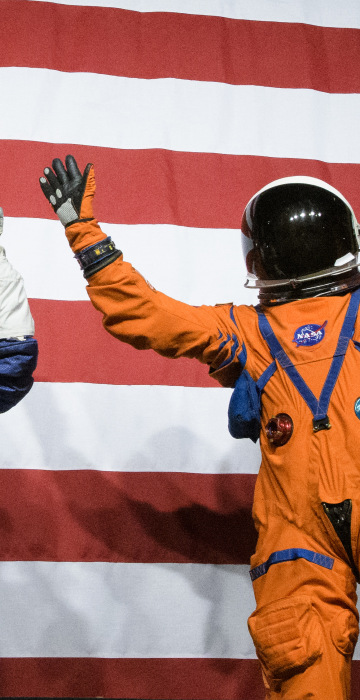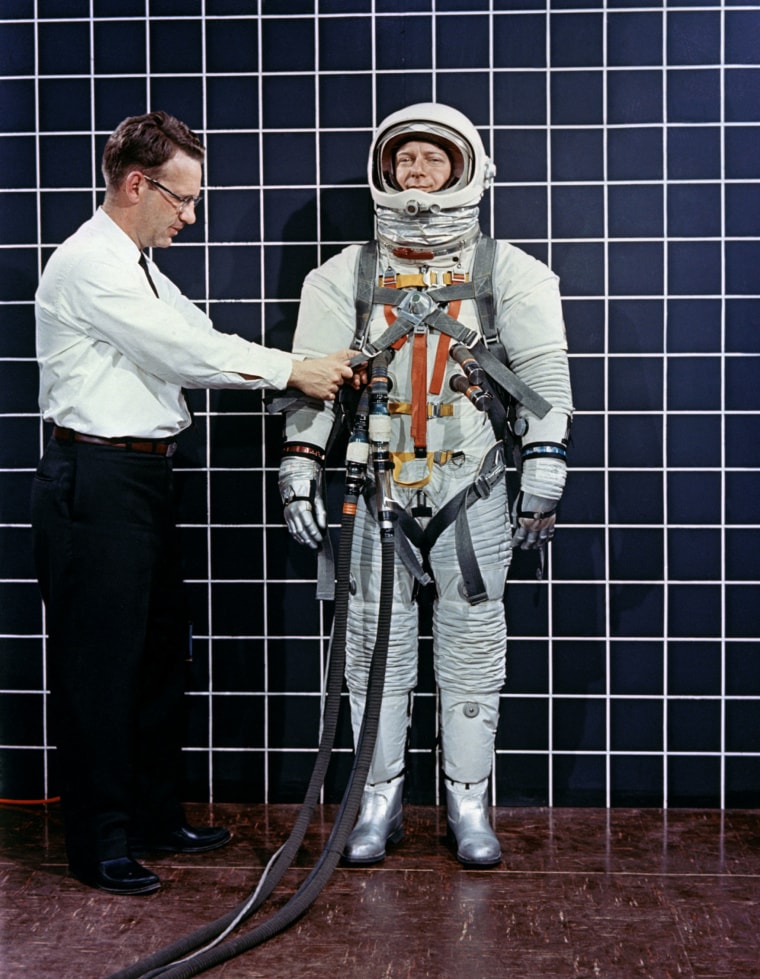
Space
From Mercury to Artemis: The evolution of the spacesuit in photos
You won't explode if you enter space without a suit, but we don't recommend it.

Artemis
Contrary to schoolhouse rumor, you won't explode if you venture into space without a suit, nor will your blood boil. You won't freeze to death either, because the lack of oxygen will kill you first.
NASA has unveiled its latest space suit designs for the upcoming Artemis program. Seen here, the xEMU, for Exploration Extravehicular Mobility Unit, will be worn during excursions on the moon and, later, Mars. To demonstrate the suit's flexibility, space suit engineer Kristine Davis picked up a rock and handed it to NASA Administrator Jim Bridenstine.
Here's a look back at the suits that keep brave space explorers alive in challenging circumstances and how they've changed from mission to mission.

Mercury
Initiated in 1958, completed in 1963, Project Mercury was the United States' first man-in-space program.
Here, Gordon Cooper, one of NASA's original seven astronauts, poses in his Mercury flight suit. A modified version of a U.S. Navy high-altitude pressure suit, it had an inner layer of Neoprene-coated nylon and an outer layer of aluminized nylon.

First human in space
Soviet cosmonaut Yuri Gagarin wore a SK-1 pressure suit on April 12, 1961, when he became the first human to journey into space.
Notable features include a visored helmet that is not detachable from the suit; an inflatable rubber collar for use in the event of water landing; a bright orange nylon oversuit, which has a mirror sewn into the sleeve to help the cosmonaut locate hard-to-see switches and gauges; and the gray-checked pressure liner with connectors for life-support and communications hoses. The suit also has leather-palm gloves, heavy leather boots and a leather-covered radio headset.
The suit at right, worn by Gagarin during training exercises, is now on display at the Smithsonian National Air and Space Museum.

First American in orbit
Astronaut John Glenn wears a training version of a Mercury spacesuit during a break from training for the Mercury-Atlas 6 mission in 1962, when Glenn became the first American to orbit Earth.
Like the Gagarin suit, this suit's design was adapted from high-altitude pressure suits worn by aircraft pilots. Glenn's suit was a lightweight multi-layered garment with an aluminized nylon cover layer. Thirteen zippers, plus custom-fitted gloves, boots and helmet, assured a snug fit.
Glenn is the only astronaut to have flown into space wearing a Mercury suit and a space shuttle suit. At the age of 77, he became the oldest man to fly into space when he joined a space shuttle Discovery mission in 1998.






Apollo 11 astronaut Buzz Aldrin stands on the moon on July 20, 1969. The plexiglass of his helmet reflects astronaut Neil Armstrong, taking his picture.
Walking on the moon's surface a quarter million miles away from Earth presented a new set of problems to spacesuit designers. Not only did the moon explorers' spacesuits have to offer protection from jagged rocks, but the suits also had to be flexible enough to permit stooping and bending.
The suits had to provide protection from bombardment by micrometeoroids, tiny particles that constantly pelt the lunar surface from deep space, but also insulate the wearer from the temperature extremes of space.
Without Earth's atmosphere to filter the sunlight, the side of a suit facing the sun may be heated to a temperature as high as 250 degrees Fahrenheit; the other side, exposed to darkness of deep space, may get as cold as minus 250 degrees Fahrenheit.

This spacesuit was worn by William Anders during the first manned flight around the moon, the Apollo 8 mission of 1968. During the moon landing missions, an Intravehicular Activity (IVA) suit was worn by the Command Module pilot, who did not leave the spacecraft. It could not be worn outside, as it did not have protection against micrometeoroids or a reflective visor. Unlike the suits worn on the moon, the IVA suit didn't have the life-support backpack. Oxygen was supplied from the spacecraft itself.


In February 1984, shuttle astronaut Bruce McCandless became the first astronaut to float in space untethered, thanks to a jetpack-like device called the Manned Manuevering Unit, or MMU.
Apollo spacesuits were basically one-piece suits, custom tailored for each astronaut. Because the shuttle astronaut corps was so much larger, suits were "off the rack," made up of many interchangeable parts.
The shuttle suits for spacewalks were much heavier than Apollo suits. The Apollo suit was designed for only one mission and it had to be lightweight to allow the astronauts to do work on the moon. The shuttle suit was designed for multiple missions and only for work in zero gravity where the astronaut does not feel the weight of the suit.
The shuttle suit with life-support system weighs about 310 pounds while the Apollo suits weighed about 180 with the life-support backpack.

The crew of the space shuttle Endeavour leaves their quarters for the launch pad on Dec. 1, 1993. From left, front row, Story Musgrave, Jeffrey Hoffman, Commander Dick Covey, back row, Kathy Thornton, Tom Akers, Claude Nicollier and pilot Ken Bowersox.
The orange launch and entry suit worn by shuttle crews was nicknamed the "pumpkin suit."


No, this is not an untethered astronaut floating away into the infinite blackness of space. It's an empty spacesuit-turned-satellite called SuitSat as it began its orbit around Earth. It was released by the Expedition 12 crew members at the International Space Station during a spacewalk on Feb. 3, 2006.
The worn-out Russian Orlan spacesuit was outfitted by the crew with three batteries, internal sensors and a radio transmitter, which faintly transmitted recorded voices of school children to amateur radio operators worldwide. After a few weeks, the suit entered Earth's atmosphere, where it burned up.
Such suits have a limited life — usually about 10 to 12 spacewalks. The equipment installed on the suits can be cannibalized for use on newer suits, but the bulky main shells must be disposed of. Sometimes they are stuffed into empty supply drones destined to dive back into the atmosphere, but often the suits are literally thrown away into space.

Constellation
Technician Bill Welch, left, stands inside a 300-pound space suit as another technician talks with him in Moses Lake, Washington in 2008. NASA scientists and contractors spent two weeks in Moses Lake field testing some of the vehicles and robots that were to be used for a planned return to the moon by 2020 as part of the Constellation program.
President Obama's 2011 budget cut the Constellation program, ending the mission to return astronauts to the moon.

Z-series
This design for the Z-2 spacesuit was released by NASA in 2014. Each iteration of the Z-series will advance new technologies that one day will be used in a suit worn by the first humans to step foot on Mars.
The Z-series suits offer improved mobility and are designed for use in space as well as on planet surfaces. Adjustable shoulder and waist sizes maximize the range of crew members who can fit into any single suit.
Instead of wearing the suit like clothing, astronauts enter the suit through a back hatch.

Starliner
In 2017, Boeing unveiled the spacesuit passengers will wear aboard the Starliner spacecraft, a next-generation space capsule that will take people to and from low-Earth orbit, including missions to the International Space Station.
According to NASA, the design is lighter and more comfortable than the spacesuits earlier astronauts wore.

Former NASA astronaut Chris Ferguson wears the Starliner suit while strapped into a mockup of the spacecraft.
The suit features a soft, lightweight helmet that zips instead of latching and gloves that are touch-screen friendly. The full suit, which includes integrated shoes, weighs about 20 pounds with all its accessories – about 10 pounds lighter than the launch-and-entry suits worn by space shuttle astronauts.

Artemis
NASA shows of its new space suit designs, xEMU, left, and the Orion Crew Survival System suit on Oct. 15, 2019.
The Orion suit is designed for a custom fit and incorporates safety technology and mobility features that will help protect astronauts on launch day and during the high-speed return to Earth.
The xEMU will allow for greater mobility, especially in the shoulders, and will be able to keep astronauts comfortable from 250 degrees Fahrenheit to minus 250 degrees Fahrenheit, NASA spacesuit designer Amy Ross said during the event.